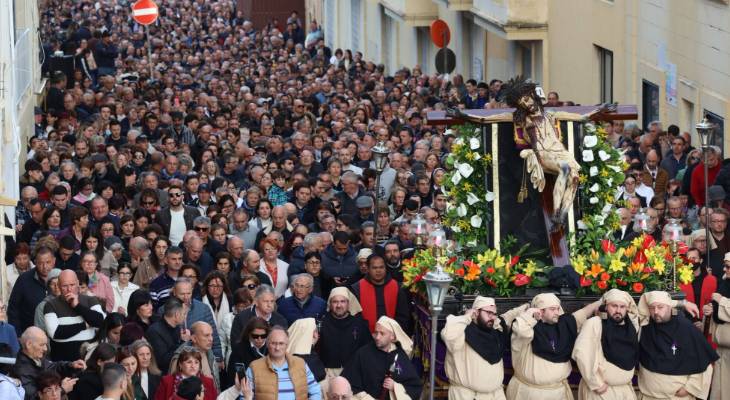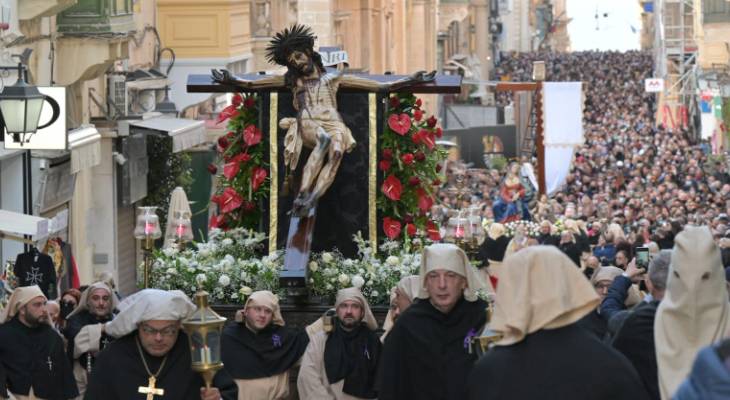The impressive crucifix, which dates to the early 17th century, has inspired countless other works of art, becoming a reference point in sacred art in Malta.
For Christians, Good Friday and Easter are the most important holidays of the year. On a superficial level, they are an occasion to reconnect with one’s roots through tradition and childhood memories. At a deeper level, they can be a meaningful moment for introspection and seeking connection with the spiritual.

In Valletta, one iconic statue has inspired thousands across the centuries to attempt this journey, as it has captured their imagination. The Ta’ Ġieżu Crucifix is a passage of faith, history, and iconography.
The sculpture of the crucified Christ, revered at the Franciscan church of St Mary of Jesus (Ta’ Ġieżu) in Valletta, is one of the oldest effigies of its kind to be found on the island. Dating back to the early 17th century, it is attributed to Frate Innocenzo from Petralia Sottana in neighbouring Sicily and is the much-loved treasure of the Archconfraternity of the Miraculous Crucifix, which is based within the same church.
Little can be known for certain about the origins of the impressive artwork, as, unfortunately, 400 years ago, records were not kept as meticulously as they are today. What is known about the wooden sculpture comes from extensive investigative research and the conservation interventions made to it across the centuries. The mystery certainly contributes to the aura surrounding the crucifix.
Viewing the impressive crucifix for the first time can be quite shocking, as the artist did not hold back in depicting the Roman torture endured by Christ in all its gore – and there is a perfectly good reason for this, which we learn from a quick dive into art history.
In fact, the crucifix expresses the spirit of the Counter-Reformation – a counter-movement within the Catholic Church that emerged as a reaction to the Protestant ideas surfacing at the time. Acknowledging the power of a strong image, the artist chose a staunchly realistic style to represent the most central image in Christian faith – the crucified Christ. Sacred art at this time was endowed with the sole purpose of inspiring a good life based on spiritual reflection. It is safe to say that the Ta’ Ġieżu Crucifix has inspired countless other works of art that followed, becoming a reference point in Maltese sacred art.
The strong following surrounding the Ta’ Ġieżu Crucifix developed and grew across the centuries, as the powerful effigy became a place of refuge for thousands.
The chapel dedicated to it, located on the right-hand side of the church in the stepped part of St John’s Street, is a unique corner of peace and worship visited by pilgrims all year round. Meditation and spiritual reflection on the story of Christ’s passion and the mystery of salvation are often led by the Franciscan friars as well as laypersons.
Around Lent, a time of reflection that lasts for the 40 days preceding Easter, interest peaks, especially during the week dedicated to the Stations of the Cross.

Archdiocese of Malta
This year, on the occasion of the Jubilee Year of Hope, which is being celebrated throughout the Catholic Church, the Archconfraternity of the Miraculous Crucifix marked the special year with an extraordinary pilgrimage of the Crucifix to Għajnsielem in Gozo. The unprecedented occasion was attended by hundreds from Malta and Gozo, as the Crucifix was carried on shoulders through the winding streets of the Gozitan town to the parish church dedicated to Our Lady of Loreto, before it made its way back home to Valletta.
The Ta’ Ġieżu Crucifix is often referred to as miraculous, as those who have found refuge and healing in its inspired contemplation have been many. In 2025, the Crucifix still draws thousands of faithful for prayer, offering solace in an increasingly superficial and fast-paced life.
Perhaps that is the greatest miracle of all!